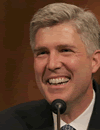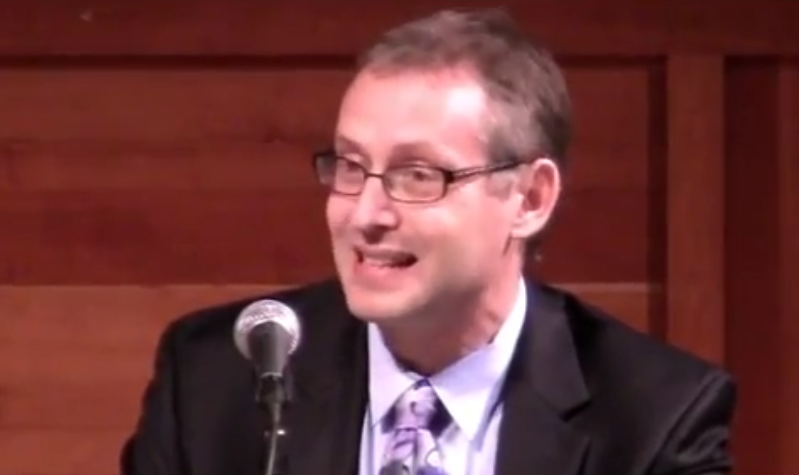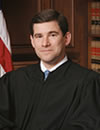Hon. Neil Gorsuch
United States Court of Appeals for the Tenth Circuit (2006-Present)
This post examines four opinions Judge Neil Gorsuch wrote or joined concerning media freedoms under the First Amendment. These cases made either defamation or invasion of privacy claims or both.[1] (For our previous analysis of Judge Gorsuch’s views on free speech, please click here.)
Before I review these cases, I want to note how much I enjoy reading Judge Gorsuch’s opinions. If President Trump selects him, I predict people will admire the rigor and eloquence of his opinions. He thoughtfully considers competing arguments, and he faithfully interprets the law and the Constitution. Fortunately, he also applies rigorous scrutiny in First Amendment speech cases.
In each of the four opinions reviewed here, he sided with the media.
- Bustos v. A & E Television Networks, 646 F.3d 762 (10th Cir. 2011)
- Mink v. Knox, 613 F.3d 995 (10th Cir. 2010)
- Alvarado v. KOB-TV, 493 F.3d 1210 (10th Cir. 2007)
- Anderson v. Suiters, 499 F.3d 1228 (10th Cir. 2007)
Judge Gorsuch authored opinions in the first two cases listed above. His writing and rigor shine in Bustos.
Bustos v. A & E Television Networks
Bustos explores the outskirts of defamation law. Is someone defamed when the defamatory statement is not exactly true but true enough?
The protagonist in this saga is Jerry Lee Bustos. Bustos exchanged fisticuffs in a minor dispute captured by prison cameras. A&E Television got the footage and made Mr. Bustos an unwitting TV ‘star.’ A&E further described Bustos as a member of the Aryan Brotherhood, a false claim, and one that caused him problems in the unforgiving world of prison.
After discussing the history and contours of the law and admitting A&E did describe Bustos as an Aryan Brotherhood member and that statement was defamatory, Judge Gorsuch explained why those facts did not entitle Bustos his desired relief.
From the opinion:
[T]o concede that a statement is defamatory is just to say it hurts. It says nothing about the truth of the matter . . .
[W]hat exactly does Mr. Bustos have to do to show that the statement he challenges is “false”? Under Colorado law, much as elsewhere, it is not enough for the plaintiff to show that the defendant got some innocuous detail wrong; the plaintiff must show that the challenged defamatory statement is not just false but material . . .
But to say that the misstatement must be material only raises questions of its own – material to whom? And for what purpose? The answer to these questions takes us back to and can be found in the interest the American defamation tort is intended to protect – the plaintiff’s public reputation. Because this is the particular purpose the defamation tort is aimed at, we assess the materiality of a misstatement by comparing the damage it has done to the plaintiff’s public reputation to the damage the truth would have caused.
To be sure, the questions whether a statement is defamatory and whether it contains a material falsehood sometimes overlap. What’s the difference between saying that the plaintiff sucker-punched an elderly man on St. Patrick’s Day, when the truth is that he bashed the elderly man with a club on a different day in March? If the plaintiff complained only about the misstatement of the date of the attack, he would lose for two reasons: nothing about the date is defamatory and in any event the error has no apparent material significance. But sometimes the material falsehood requirement does distinct and important work. If the same plaintiff complained about the statement that he had sucker-punched the old man, the statement is surely a defamatory one. Yet the plaintiff still might not recover because the statement could be found substantially true – the report might have been wrong about how he went about beating the old man, but it isn’t at all obvious that the difference is one that matters for purposes of the plaintiff’s public reputation.
We don’t doubt that the public thinks worse of Aryan Brotherhood prison gang members than standard-issue prisoners. But that only means A & E’s statement – its indication that Mr. Bustos is a member of the Aryan Brotherhood – is defamatory or hurtful to his public reputation. We must still compare A & E’s statement against the truth of the matter. And on that score the facts reveal that, while Mr. Bustos isn’t formally a member of the Brotherhood, he surely did affiliate with the organization. In the A & E footage, Mr. Bustos is seen chatting with two Aryan Brotherhood members and a member of yet another gang up until the moment he gets punched. And his relationship with the Brotherhood hasn’t been limited to rec yard chats. In a conspiracy ultimately detected and disrupted by prison officials, Mr. Bustos agreed to receive balloons filled with heroin from a prison visitor; insert them into his body; and then pass them along to three prison gangs, including the Aryan Brotherhood. When things went awry, Mr. Bustos found himself – balloons and all – locked in solitary confinement. After this delay upset certain intended recipients, Mr. Bustos sent a handwritten apology to an Aryan Brotherhood leader. The note – which refers to the leader repeatedly as “bro” – explains the situation and promises the balloons will soon be on their way. It concludes by sending Mr. Bustos’s “respect” and asking the Aryan Brotherhood leader to “give my regards” to still three other Brotherhood members.
Comparing the challenged defamatory statement (membership in the Aryan Brotherhood) to the truth (conspiring with and aiding and abetting the Aryan Brotherhood), we cannot see how any juror could find the difference to be a material one – that is, likely to cause a reasonable member of the general public to think significantly less favorably of Mr. Bustos. The difference or delta between the defamatory statement and the truth might cause some modicum of additional injury to his reputation, that we don’t deny, but it is not one a juror could find likely to be significant to a reasonable person. Tellingly, Mr. Bustos points to nothing in the record he has developed through the entire discovery phase of this case suggesting that his standing in the public eye would be improved at all by more careful explication of the true particulars of his involvement with the Brotherhood.
Mr. Bustos protests that calling him a member of the Aryan Brotherhood has a special sting given that he’s Hispanic. He reminds us that the Aryan Brotherhood is a white-supremacist organization, and argues that falsely associating him with the group suggests that he’s someone who has “renounc[ed] his Hispanic heritage.” But even granting all this to Mr. Bustos for argument’s sake, the truth is that he did intentionally aid and abet the Brotherhood. And having willingly helped the Brothers flout prison security measures as part of a criminal conspiracy, it’s a few years too late to take a principled stand against their agenda. To the extent reasonable persons would find the views and practices of the Brotherhood abhorrent – and surely they would – they would also be appalled that Mr. Bustos has given that group his aid and comfort, risking administrative and criminal sanction to help their cause.
Of course, this isn’t to say that no one makes a distinction between the Aryan Brotherhood’s criminal accessories and its full-fledged members; it’s almost certain, for example, that the Brotherhood does. But, as we have explained, defamation doesn’t vindicate factual mistakes of consequence only to such insular groups. And the harms Mr. Bustos alleges as a result of these misunderstandings come down to an increased risk of violence and disruption of the existing prison order – allegations unrelated to any damage done to Mr. Bustos’s public reputation. Inciting prisoners to violence might have been cause to indict A & E for defamation at one time under English criminal law, but it’s not actionable under contemporary American law.
Let’s look at Mink v. Knox, in which Judge Gorsuch wrote a short concurring opinion that joined the majority in its reasoning with one exception. To set up the case, here are some quick facts from the majority opinion by Judge Seymour:
Mr. Mink, a student at the University of Northern Colorado (“UNC”), created a fictional character, “Junius Puke,” for the editorial column of his internet-based journal, The Howling Pig…. The editorial column displayed altered photographs of Junius Peake, a UNC professor, wearing dark sunglasses and a Hitler-like mustache. Junius Puke’s editorial column addressed subjects on which Mr. Peake would be unlikely to write, in language he would be unlikely to use, asserting views that were diametrically opposed to Mr. Peake’s. Mr. Peake, who was not amused, contacted the Greeley police, who started investigating a potential violation of Colorado’s criminal libel statute, COLO.REV.STAT. § 18-13-105. In conformance with Colorado Revised Statute § 20-1-106.1, the detective in charge prepared a search warrant affidavit to submit to the office of the district attorney for legal review. The deputy district attorney, Susan Knox, reviewed and approved the search warrant affidavit, which was identical to the warrant with respect to the eleven paragraphs listing the items to be seized. The search warrant and affidavit were both attached to Mr. Mink’s amended complaint, and are attached to this opinion as Exhibits A and B. The affidavit and warrant were presented to and approved by a magistrate judge. The Greeley police then searched the home where Mr. Mink lived with his mother and confiscated their personal computer, as well as written materials referencing The Howling Pig
Mr. Mink and his mother subsequently filed suit in federal district court against the City of Greeley, Colorado, the district attorney, Detective Ken Warren, and a “John Doe” assistant district attorney, seeking damages for the search and seizure, among other things.
The panel ruled for Mink, holding the First Amendment protected the parody. Judge Gorsuch wrote separately. His concurrence carefully analyzed the issues, but his curiosity makes you wonder where a much more difficult and original parody case might lead him. On balance, I think his opinion states, fairly, that the majority needlessly ventured. And that he was thankful he avoided the “thickets” that a much more difficult parody question might present.
From Judge Gorsuch’s concurrence:
I agree with the court’s holding in all respects and join its reasoning with one minor exception. Even with respect to that exception, I agree with the result the court reaches, arriving at a common destination but only by a different route.
The question the court confronts … is whether probable cause existed to think that Mr. Mink’s column constituted “criminal libel.” I agree with my colleagues that the answer to that question must be “no.” I reach this conclusion for a simple and straightforward reason: this court has already said so…. Pring v. Penthouse International, Ltd. established in this circuit the rule that the First Amendment precludes defamation actions aimed at parody, even parody causing injury to individuals who are not public figures or involved in a public controversy…. [This] is thus the beginning and end of my inquiry on that question.
After noting Pring … the majority proceeds … to offer a lengthy new defense of that decision. The majority may be right in all it says. But this isn’t beyond peradventure. As the majority notes, the Supreme Court has yet to address how far the First Amendment goes in protecting parody. And reasonable minds can and do differ about the soundness of a rule that precludes private persons from recovering for reputational or emotional damage caused by parody about issues of private concern. One might argue, for example, that such a rule unnecessarily constitutionalizes limitations that state tort law already imposes. Or that such a rule may unjustly preclude private persons from recovering for intentionally inflicted emotional distress regarding private matters, in a way the First Amendment doesn’t compel.
Respectfully, I would avoid these thickets. Whoever has the better path through them, it’s better yet that we sidestep them altogether. To decide the case currently before us, it’s enough to say we are bound by Pring, and so was the district court. Beyond that, I would not venture. Accordingly, I join all but Section II.B.1.a of the court’s opinion and concur in its judgment.
In Alvarado v. KOB-TV, Judge Gorsuch joined a panel opinion authored by Judge David M. Ebel, protecting First Amendment rights in the face of unpleasant facts.
A woman claimed two undercover officers sexually assaulted her. The authorities investigated through sealed warrants. A local news station learned of the investigation, publicized the officers’ names, and sought comment at their residences.
Evidence cleared the officers, but they sued the city government and the news station for privacy torts. The appeals court tossed the suit, holding that neither claim withstood the high evidentiary bar:
[W]e are among a number of courts that have found that police misconduct allegations specifically and officer qualifications generally are a matter of public interest in First Amendment analyses….
[T]he weight of authority suggests that accurate news reporting – even when it is likely to have an adverse impact on the subjects of the report – usually does not give rise to an action for intentional infliction of emotional distress, and [Police Officers] Alvarado and Flores have alleged no facts that support an exception to the general rule. We affirm dismissal of [these] claims…
Anderson too involved the nexus of First Amendment media rights, uncomfortable facts, and rights to privacy. Judge Gorsuch joined the opinion by Judge Mary Beck Briscoe.
Plaintiff Audra Anderson believed her estranged husband raped her after finding a video depicting sex acts while she was unconscious. She gave the tape to police after getting assurances of confidentiality. But a local newscast aired limited parts of the tape without her consent. Before this, the police officer asked her to speak with a reporter. She refused, but the officer put the reporter on the phone anyway.
Anderson sued the officer, KOCO-TV, and other media defendants. As noted in the opinion, she “alleged that all of the defendants had violated her federal constitutional right to privacy in the videotape. She also asserted that the media defendants had invaded her privacy rights under Oklahoma tort law.”
The appeals court upheld rulings favoring the media on both privacy claims. First, Anderson alleged the media entity violated her civil rights by airing limited parts of the videotape. To be successful, Anderson would have to prove the TV station was a “state actor” for purposes of their conduct. The court found they were not.
The second privacy claim alleged publication of private facts. The court concluded whatever harm or distress the limited airing of the videotape produced for Anderson, it did not overcome the matter’s legitimate public interest.
From the opinion joined by Judge Gorsuch:
The requirement that the published private facts not be of legitimate public concern is both an element of the common law tort and a constitutional limitation imposed by the First Amendment…. This limitation on the publication-of-private-facts tort protects “the right of the press to disseminate newsworthy information to the public.” A matter can be of legitimate public concern even though it concerns private individuals, like Anderson, “‘who have not sought publicity or consented to it, but through their own conduct or otherwise have become a legitimate subject of public interest.’”
[1] Internal citations to other cases have been omitted from most excerpts below.














